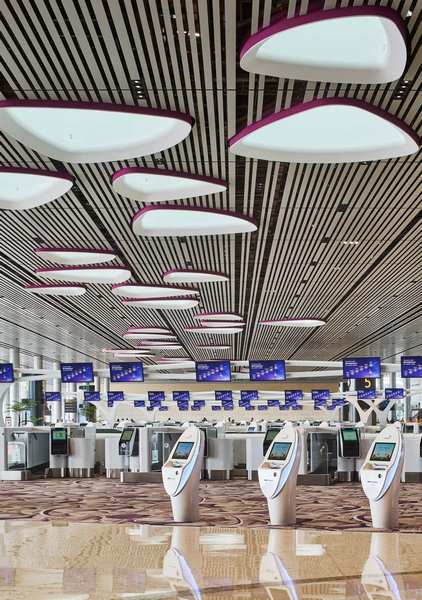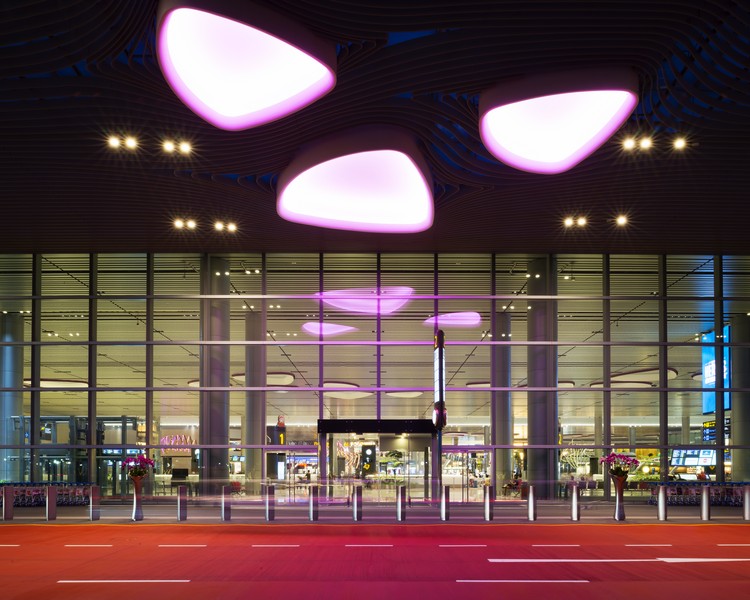Benoy prides itself on design solutions that are culturally relevant, human-centric and sustainable. The global firm’s primary involvement in the architecture, interior and wayfinding design for Singapore’s new 225,000m² Terminal 4 (T4) at Changi Airport is no different.
 For the now Dubai-based Neil Kee, Director, who has been engaged in the project since the design process started in 2012, the creation of T4 has been a testament to the entire project team: “The team sought to evolve aviation design and make the user experience our priority. We studied the passenger journey from beginning to end to understand how users move through an airport, how they use the space, what the pain points are and what is needed to create a positive user experience.
For the now Dubai-based Neil Kee, Director, who has been engaged in the project since the design process started in 2012, the creation of T4 has been a testament to the entire project team: “The team sought to evolve aviation design and make the user experience our priority. We studied the passenger journey from beginning to end to understand how users move through an airport, how they use the space, what the pain points are and what is needed to create a positive user experience.
 The outcome of this study allowed us to identify the key stressors in wayfinding, immigration and security, and a general sense of place. With this knowledge we developed the concept of Fast and Seamless Travel (FAST), to help passengers navigate the terminal effortlessly.”
The outcome of this study allowed us to identify the key stressors in wayfinding, immigration and security, and a general sense of place. With this knowledge we developed the concept of Fast and Seamless Travel (FAST), to help passengers navigate the terminal effortlessly.”
Kee explains that early on in the design process immigration and the screening process were identified as the most stressful part of any passenger’s journey. As such the team at Benoy was able to form a building around features that would help de-stress this experience.
“A fantastic example of this is the 300m long Central Galleria; a space which visually connects the departure, check-in, arrival and transit areas. The idea was to allow passengers and visitors a glimpse of the journey to come and also the opportunity to remain in visual contact with loved ones as they pass through to the departure area. It’s all driven by reducing stress within travel experience.
The space also looks over the baggage claim area and features abundant skylights, planted green walls, custom furnishings, and the terminal’s main art installation, the kinetic petal cloud,” he adds.
 It’s a concept which anyone who has ever moved through an airport will be able to appreciate. And if Benoy’s creation of a terminal immersed in natural daylight, adorned with more than 340 species of flora and fauna as well as art and sculptures does not provide almost instant comfort to the senses, the use of technology is breathtaking in its comparison to the usual stresses of any busy international airport.
It’s a concept which anyone who has ever moved through an airport will be able to appreciate. And if Benoy’s creation of a terminal immersed in natural daylight, adorned with more than 340 species of flora and fauna as well as art and sculptures does not provide almost instant comfort to the senses, the use of technology is breathtaking in its comparison to the usual stresses of any busy international airport.
State of the art facial recognition removes the need for manual identity verification by staff, while computed tomography (CT) security screening for hand-carry luggage removes the arduous process of unpacking electronics while going through security. An automated tray return system and enhanced passenger screening also play a role in streamlining the travel experience. While Benoy is perhaps best known for its retail designs, there are clearly parallels with malls and mixed-use developments when designing for public infrastructure projects such as T4. For Hong Kong-based Craig Menzies, Director of Interiors at Benoy, the only difference is that in an airport you have a very captive audience as passengers follow a defined path through the airport to their gate.

“We blurred the retail boundaries by using the circulation space and limiting obtrusive storefronts which allows passengers to move freely through the terminal and, in turn, elevate their experience. With more than 80 stores and restaurants covering 16,000 square metres, T4 offers a broad mix in a single environment, from local to international, luxury to pop-up which has also been carefully curated and positioned to travellers. This is where Benoy’s expertise in creating retail environments and ‘Places for people’ really comes to forefront,” he adds.
But beyond the technology and intricate retail planning that brings Benoy’s vision of seamless travel to life is the interior design. Indeed, as Menzies adds, with Singapore being the ‘garden city’ it’s only natural that planting and the heritage of the city would become key features of Benoy’s design.
From the various planting areas that showcase a variety of orchids and seasonal floral displays to the huge trees in the sunlit Central Galleria, fish pond and green walling, Benoy’s efforts are geared to enhancing the customer experience and lending a calming effect. In addition, the inclusion of art and sculptures throughout the building are centred around a kinetic petal cloud sculpture which moves in harmony to music. Inspired by orchid petals, this motif is found throughout the architecture and interior design of the terminal, not least in the design of the carpeting, included not only as an artistic feature but also as a mechanism to contain noise.
Furthermore, the heritage of the city plays a vibrant part in the design aspect, with a heritage zone housing local retail outlets carrying a strong sense of place with façades inspired by the old shop houses that were once prominent in the city.
Stunning and immersive LED displays within this zone and in the arrivals area are designed to entertain and showcase the airport’s connectivity to the region.
“Singaporeans are extremely proud of Changi Airport as it has played a key role in Singapore’s successful growth. This pride becomes extremely evident when you take time to understand the amount of people that visit Changi but don’t fly anywhere!” notes Kee.
For Hong Kong-based Simon Bee, Global Design Director, T4 represents Benoy’s further foray into the world of aviation.
“It has proved to be an amazing and fulfilling experience and has given every member of the team a unique outcome. From humble beginnings as a terminal for budget airlines, T4 has now become the ‘boutique’ terminal we always hoped for – attracting the attention of major international carriers who are taking stands and lounge space.”
 Looking at Benoy’s success in the T4 project, it comes as no surprise that they are also involved in designing Jewel Changi Airport, a future iconic attraction located at the heart of the airport due to complete next year, as well as commercially masterplanning the major London Heathrow expansion.
Looking at Benoy’s success in the T4 project, it comes as no surprise that they are also involved in designing Jewel Changi Airport, a future iconic attraction located at the heart of the airport due to complete next year, as well as commercially masterplanning the major London Heathrow expansion.
As Menzies concludes: “We know that the role of the airport has changed and will continue to change. T4 and Jewel Changi Airport are prime examples of where the sector is going in the future. We know that by putting the customer experience at the heart of the design, we are able to harness and unlock the potential of these buildings.”











